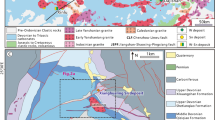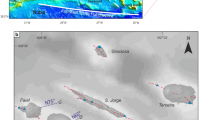Abstract
The distribution of elements and their correlations were analyzed throughout the section of the Kivakka intrusion to formulate the geochemical tendencies in the behavior of elements of different groups during formation of layered basic-ultrabasic complexes. (1) It was shown that the distribution of trace elements in the layered series is controlled by their ability or inability to enter isomorphically the cumulus minerals. The distribution of trace elements that occur as isomorphic admixtures in cumulus minerals (Cr, Mn, Zn, Co, Ni, and Ti), regardless of their geochemical type, is correlated with the crystallization order and distribution of minerals in the silicate matrix of the rocks. Elements that practically are not involved into silicates (S, Cu, Ag) show no any systematic variations; i.e., they are not controlled by fractionation of major rock-forming mineral. Their behavior is driven by the appearance of individual phase—sulfide melt, whose localization, formation time, and scales of fractionation are determined by saturation of parental melt in sulfide sulfur and general degree of its fractionation. (2) The comparison of cross-section variations of elements that isomorphically substitute for major elements in the Fe-Mg silicates, but differ in chalcophile affinity (in order of increase of chalcophile affinity: Mn → Zn → Co → Ni) reflects the contribution of unmixing and fractionation of sulfide melt during intrusion solidification. This is quantitatively defined primarily by partitioning coefficients of elements between cumulus silicates and magmatic melt, on the one hand, and between magmatic and sulfide melts, on the other hand. (3) The absence of simple correlation between local sulfide-rich horizons and silicate matrix of the rocks and signs of independent fractionation of sulfide melt prevent any attempts to predict the localization and scales of local sulfide mineralization within the layered series on the basis of petrochemical and related criteria. Only tendencies in the distribution of ore elements and sulfur across the section can be used for these purposes.
Similar content being viewed by others
References
M. M. Lavrov, Precambrian Hyperbasites and Layered Peridotite-Gabbro-Norite Intrusions of North Karelia (Nauka, Leningr. otd, Leningrad, 1979) [in Russian].
E. V. Koptev-Dvornikov, B. S. Kireev, N. F. Pchelintseva, and D. M. Khvorov, “Distribution of Cumulative Mineral Assemblages, Major and Trace Elements over the Vertical Section of the Kivakka Intrusion, Olanga Group of Intrusions, Northern Karelia,” Petrologiya 9(1), 3–27 (2001) [Petrology 9, 1–24 (2001)].
A. A. Yaroshevskii, “Geochemical Structure of Magmatic Complexes: An Example of the Kivakka Layered Olivinite-Norite-Gabbronorite Intrusion, Northern Karelia,” Geokhimiya, No. 12, 1251–1270 (2004) [Geochem. Int. 42, 1107–1125 (2004)].
V. M. Goldsshmidt, “The Principles of Distribution of Chemical Elements in Minerals and Rocks,” J. Chem. Soc. London, 655–673 (1937); (GONTI NKTP SSSR, Moscow, 1938, pp. 215–242] [in Russian].
V. M. Goldshmidt, “The Geochemical Background of Minor Element Distribution,” [Soil Sci. 60 (1), (1945); Izd-vo inostr.liter, Moscow, 1952).
V. M. Goldschmidt, Geochemistry (Oxford Univ. Press, London, 1954).
L. R. Wager and R. L. Mitchell, “Preliminary Observations on the Distribution of Trace Elements in the Rocks of the Skaergaard Intrusion, Greenland,” [Mineral. Mag. 26 (180), 283–296 (1943); Inostrannaya Literatura, Moscow, 1952).
L. R. Wager and R. L. Mitchell, “The Distribution of Trace Elements During Strong Fractionatin of Basic Magma—a Further Study of the Skaergaard Intrusion, East Greenland,” Geochim. Cosmochim. Acta 1(3), 129–208 (1951).
S. R. Noskolds and R. L. Mitchell, “The Geochemistry of Some Caledonian Plutonis RoCks: A study of the Relationship between the Major and Trace Elements of Igneous Rocks and Minerals,” in Trans. R. Soc. Edinb. 1944–1948 61(Pt. 2), 533–575.; Izd-vo inostr.liter, Moscow, 1952), pp. 295–366 [in Russian].
S. R. Nockolds and R. Allen, “The Geochemistry of Some Igneous Rock Series. Part I,” Geochim. Cosmochim. Acta 4(3), 105–142 (1953). (Inostrannaya Literatura, Moscow, 1958), pp. 9–63 [in Russian].
S. R. Noskolds and R. Allen, “The Geochemistry of Some Igneous Rock Series. Part II,” Geochim. Cosmochim. Acta. 5(6), 245–285 (1954). (Inostrannaya Literatura, Moscow, 1958).
S. R. Noskolds and R. Allen, “The Geochemistry of Some Igneous Rock Series. Part III,” Geochim. Cosmochim. Acta 9(1/2), 34–77 (1956) (Izd-vo inostr.liter, Moscow, 1958), pp. 114–175 [in Russian].
S. R. Nockolds, “The Behavior of Some Elements During Fractional Crystallization of Magma,” Geochim. Cosmochim. Acta 30(2), 267–278 (1966).
D. M. Shaw, Interprétation Géochimique des élémentss eu Traces Dans les Roches Cristallines (Masson et Co, Paris, 1964; Nedra, Leningrad, 1969).
K. G. Cox, J. D. Bell, and R. J. Pankhurst, The Interpretation of Igneous Rocks. (Allen & Unwin, London, 1979; Nedra, Moscow, 1982).
N. F. Pchelintseva and E. V. Koptev-Dvornikov, “Behavior of Cu, Ag, Pt, Pd and Au during Crystallization of the Kivakka Layered Intrusion (Northern Karelia),” Dokl. Akad. Nauk 323(5), 935–938 (1992).
N. F. Pchelintseva and E. V. Koptev-Dvornikov, “Accumulation of Noble Metals in the Course of Crystallization of the Kivakka Layered Intrusion (Northern Karelia),” Geokhimiya, No. 1, 97–112 (1993).
Ya. V. Bychkova, S. V. Bolikhovskaya, O. A. Andreeva, and O. Yu. Zakrevskaya, “Spatial Distribution of Low-Sulfide Platinum Group Element Mineralization in the Kivakka Intrusion, Northern Karelia,” Geokhimiya, No. 1, 45–62 (2009) [Geochem. Int. 47, 41–57 (2009)].
N. F. Pchelintseva and E. V. Koptev-Dvornikov, “On the Genesis of Platiniferous Low-Sulfide Rocks in the Kivakka Layered Intrusion, Northern Karelia,” Geokhimiya, No. 6, 679–685 (2008) [Geochem. Int. 46, (2008)].
Author information
Authors and Affiliations
Corresponding author
Additional information
Original Russian Text © A.A. Yaroshevskii, N.F. Pchelintseva, 2010, published in Geokhimiya, 2010, Vol. 48, No. 7, pp. 708–722.
Rights and permissions
About this article
Cite this article
Yaroshevskii, A.A., Pchelintseva, N.F. Geochemical structure of the Kivakka layered olivinite-norite-gabbronorite intrusion, North Karelia: Distribution of chalcophile elements. Geochem. Int. 48, 664–677 (2010). https://doi.org/10.1134/S0016702910070049
Received:
Published:
Issue Date:
DOI: https://doi.org/10.1134/S0016702910070049




